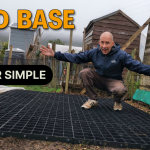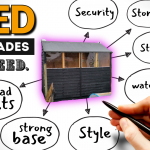Creating a compost bin from pallets is an excellent way to recycle wood and build an affordable and effective system for composting organic waste. Here are the steps to make a compost bin from pallets:
- Materials and Tools Needed:
- 9. Maintain the Compost:
- 10. Harvest the Compost:
- Compost bin from pallets (YouTube) step by step.
Materials and Tools Needed:
- Wooden pallets (4 pallets are commonly used)
- Screws or nails
- Screwdriver or hammer
- Saw (optional)
- Wire mesh or old window screens (optional)
- Hinges and a latch (optional)
- Landscape fabric or burlap (optional)
1. Select Your Location:
- Choose a location that receives partial sunlight. While full sun can speed up decomposition, excessive heat can dry out your compost. Partial shade helps maintain the right moisture level.
- Ensure easy access to water because compost requires adequate moisture. A nearby hose or water source is beneficial.
2. Prepare Your Pallets:
- When selecting pallets, look for those labeled with the HT (heat-treated) stamp rather than MB (methyl bromide), as MB-treated wood can be harmful when composted.
- Sand down any rough edges or splinters to make the compost bin safer to use and more aesthetically pleasing.
3. Form the Sides and Back:
- Position the two back pallets with their length running vertically. This arrangement provides stability and height to the back of the bin.
4. Secure the Pallets:
- Use screws for a more secure connection, as they are less likely to come loose over time compared to nails.
- Ensure the structure is level to prevent any tipping or leaning, which could disrupt the composting process.
5. Create a Gate (Optional):
- If you choose to add a gate, it can be useful for easy access and turning the compost. Consider using a latch that keeps it securely closed but is easy to open when needed.
6. Add Ventilation (Optional):
- Proper airflow is essential for decomposition. Consider adding multiple layers of wire mesh or screens to the top of the bin.
- Good ventilation prevents the compost from becoming anaerobic (without oxygen), which can lead to unpleasant odors.
7. Line the Bin (Optional):
- If you line the inside of the bin, ensure that it allows water to drain through. The purpose is to prevent compost from falling out, not to hold in excess moisture.
8. Start Composting:
- Maintain a balanced mix of green and brown materials. Green materials include kitchen scraps, grass clippings, and coffee grounds, while brown materials include leaves, straw, and cardboard.
- Avoid adding diseased or pest-infested plants, as composting may not kill all pathogens or pests.
- Turn or mix the compost regularly, at least once a month, to aerate it and distribute microorganisms responsible for decomposition.
9. Maintain the Compost:
- Keep the compost pile moist but not waterlogged. It should feel like a damp sponge. Water as needed to maintain this consistency.
- Monitor the temperature; a well-functioning compost pile generates heat, which helps break down materials. Temperatures between 120-160°F (49-71°C) are ideal.
10. Harvest the Compost:
- The finished compost will be dark, crumbly, and have an earthy smell. It should resemble rich, fertile soil.
- Remove the finished compost from the bottom of the bin and use it to enrich your garden soil.
Remember that patience is key when composting. It can take several months to a year to produce usable compost. By creating a compost bin from pallets and following these tips, you’re contributing to sustainability by recycling organic waste and improving your garden’s soil health.
Compost bin from pallets (YouTube) step by step.
Watch us on YouTube in this follow along video https://youtu.be/xRQmKO07KUg
What Next?
👇🏼 Let me Guide you through the season “NEWSLETTER” ✅ Always know what to sow and when, your full guide to the growing season. (Monthly Newsletter) Simple easy to follow (No Fluff, Spam or filler) just good advice. https://veggiepatchideas.substack.com/
✅ Helpful links
Take a look at my Amazon store front for guides and product reviews of the things that you need.
Plastic shed base kit Buy on Amazon
RHS: facts about grow your own Click here
Just starting your veggie patch? Start here with our beginners guide
Problems on the allotment? Remove Couch Grass or Remove Bindweed
Looking for an allotment in the UK? Try searching here first GOV.UK
The national allotment society Click Here
Other sites we love Gardeners world


